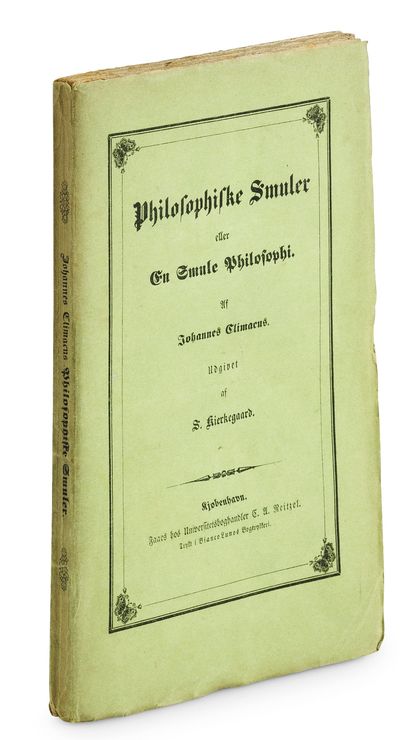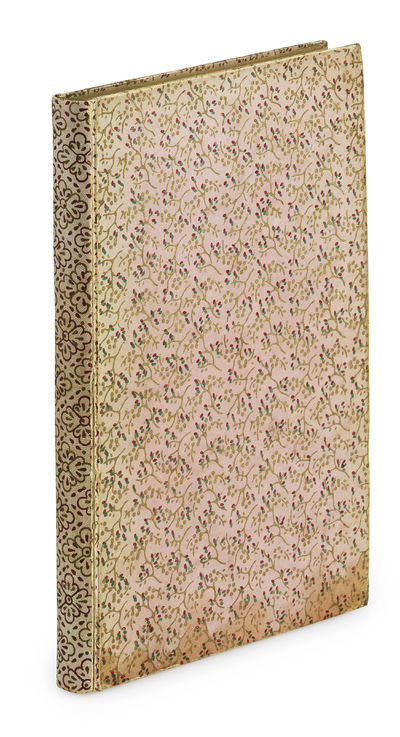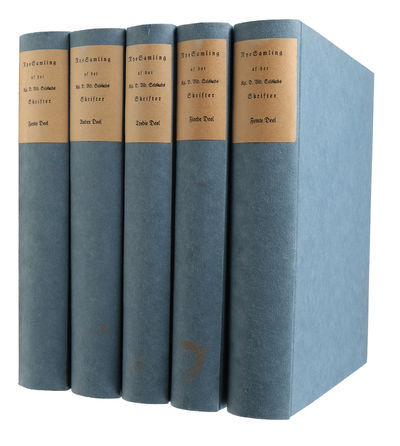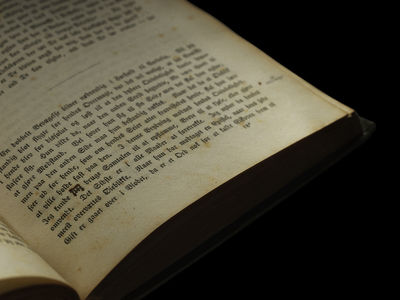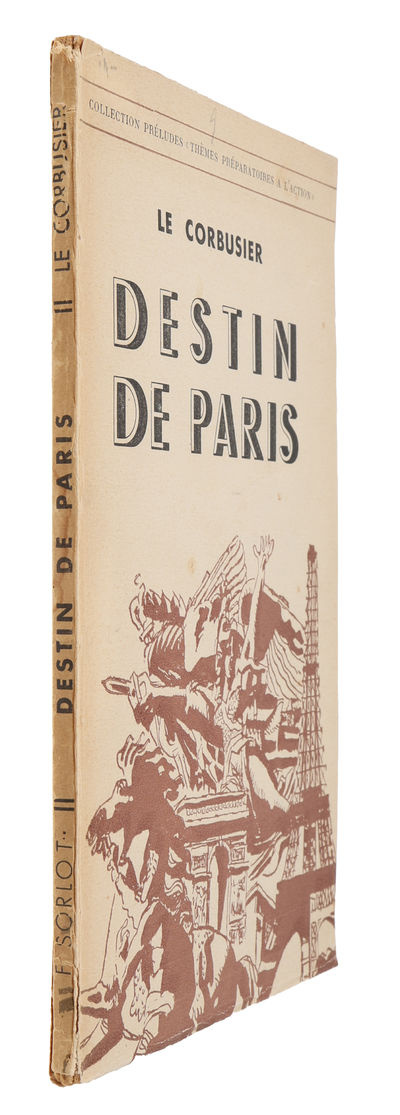KIERKEGAARD, SØREN.
Begrebet Angest. En simpel psychologisk=paapegende Overveielse i Retning af det dogmatiske Problem om Arvesynden. Af Vigilius Hafniensis. - [THE ONLY KNOWN COPY ON SPECIAL PAPER OF THE WORK THAT INTRODUCED "ANGST" IN PHILOSOPHY]
Herman H. J. Lynge & Søn A/S
lyn62259
Kjøbenhavn, Reitzel, 1844. 8vo. (8), 184 pp. Bound in a black glitted full paper binding mimicking Kierkegaard’s gift-bindings. With Gothic gilt lettering and printing year to spine. Top edge gilt, otherwise uncut. Bound by Anker Kyster’s Eftf. 1958, more specifically Bent Andree, with his name in pencil under the book-binder stamp on front free end-paper. A bit of wear to extremities. One leaf loose. The copy is a most curious one. It was been washed and restored and then bound by one of Denmarks’ best bookbinders of all time, clearly under specific instructions to both keep it original, but to also reflect the typical bindings Kierkegaard had made. The copy is on fine, bright white vellum-paper (!), uncut, and bound with the original back-strip with the original printed title-label, preserving all of the printed text and with blank blue wrappers of the exact same paper as the back-strip. To our knowledge, The Concept of Anxiety did not appear in blue blank wrappers. It did, however, appear in the characteristic blue paper binding. The wrappers here bound in, however, do not match this paper exactly.
A unique copy of the scarce first edition of this classic of Existentialism, being the only known copy printed on fine paper. The Concept of Anxiety is one of Kierkgaard's greatest works, his primary psychological work, and the work with which "Angst" is introduced in philosophy. It is futhermore (together with Sixteen Unbuilding Discourses - the amputated Eighteen Upbuilding Discourses), the rarest of Kierkegaard's works, at is was printed in half as many copies as his other works. Not a single presentation-copy of the work is known to exist, no copy on special paper has been registered (before this), and merely a single copy of the work is listed in the auction catalogue of Kierkegaard’s books sold after he died (the whereabouts of this copy unknown). This could possibly be the hitherto unlocated copy from Kierkegaard’s own collection. Or it could be a copy he gave away, the only one to have ever surfaced. It is undoubtedly one or the other, seeing that it is on special vellumpaper, on which Kierkegard only had copies made for himself, for presentation, or for Regine.There could be several explanations for the mystery of the bound in wrappers: 1) they are new wrappers made to match the original spine with the original printed title-label; 2) they are the original blue paper taken off the original cardboard-boards in order to bind them in a binding that mimics a Kierkegaardpresentation-binding; 3) they are unknown original wrappers, not previously registered for The Concept of Anxiety. It is this classic of Existentialism that introduced the notion of “Angst” (anxiety) in philosophy. If Kierkegaard had written nothing else, The Concept of Anxiety alone would have cemented him as one of the most important thinkers since antiquity. Nowhere else can one find an account of the concept of anxiety that comes close in importance to the one Kierkegaard gives in the present work. Using the Fall in the Garden of Eden as the foundation of the analysis, he succeeds in describing what no-one has been able to before or since. “Long before modern psychology had entered puberty, Kierkegaard unfurled advanced psychological concepts that in many senses were Freudian before Freud was around. In his primary psychological work, The Concept of Anxiety, he presents his detailed analyses of the relationship of anxiety to phenomena such as freedom, sexuality, original sin, and history.” (The Søren Kierkegaard Research Centre). Being one of his most important and influential philosophical works, The Concept of Anxiety is essential to all later existentialist writers. It was arguably this work that more than any other influenced Existentialism. The work bears a printed dedication to his beloved Poul Martin Møller, one of the most beautiful and moving dedications in a philosophical work. Poul Martin Møller was his philosophy professor, but more than that he was a moral mentor and one of a few people that Kierkegaard truly admired and cared for. Poul Martin Møller died in 1838, leaving almost no published works behind; he is the only person outside of Kierkegaard’s immediate family (here including Regine), who had been honoured with a printed dedication in any of his books. Apart from the title Sixteen Upbuilding Discourses (the amputated Eighteen Upbuilding Discourses – without the two that were quickly sold out), The Concept of Anxiety is by far the scarcest of Kierkegaard’s works – “The Concept of Anxiety was only printed in 250 copies!” (Textspejle, p. 58, translated from Danish), which is ca half of most of the other works. It is, interestingly, the only one of the pseudonymous writings from the period that was reprinted, despite the poor sales numbers of the first issue. In the summer of 1847, when Reitzel buys the remainders of the first issue, a mere 165 copies of what is arguably now considered Kierkegaard’s most important work had been sold. The Concept of Anxiety is not only notorious for its pivotal importance in the history of philosophy and for essentially being the theoretical foundation of Existentialism; among Kierkegaard collectors and bibliophiles in general, it is also notorious for its scarcity, having been printed in a mere ca 250 copies. Furthermore, like Fear and Trembling, not a single presentation-copy of the work is known to exist, nor had any copy printed on special paper ever been discovered (until now). A single copy of the work is listed in the auction catalogue of Kierkegaard’s books sold after he died. But the whereabouts of this copy is unknown (possibly until now). Himmelstrup 62.
A unique copy of the scarce first edition of this classic of Existentialism, being the only known copy printed on fine paper. The Concept of Anxiety is one of Kierkgaard's greatest works, his primary psychological work, and the work with which "Angst" is introduced in philosophy. It is futhermore (together with Sixteen Unbuilding Discourses - the amputated Eighteen Upbuilding Discourses), the rarest of Kierkegaard's works, at is was printed in half as many copies as his other works. Not a single presentation-copy of the work is known to exist, no copy on special paper has been registered (before this), and merely a single copy of the work is listed in the auction catalogue of Kierkegaard’s books sold after he died (the whereabouts of this copy unknown). This could possibly be the hitherto unlocated copy from Kierkegaard’s own collection. Or it could be a copy he gave away, the only one to have ever surfaced. It is undoubtedly one or the other, seeing that it is on special vellumpaper, on which Kierkegard only had copies made for himself, for presentation, or for Regine.There could be several explanations for the mystery of the bound in wrappers: 1) they are new wrappers made to match the original spine with the original printed title-label; 2) they are the original blue paper taken off the original cardboard-boards in order to bind them in a binding that mimics a Kierkegaardpresentation-binding; 3) they are unknown original wrappers, not previously registered for The Concept of Anxiety. It is this classic of Existentialism that introduced the notion of “Angst” (anxiety) in philosophy. If Kierkegaard had written nothing else, The Concept of Anxiety alone would have cemented him as one of the most important thinkers since antiquity. Nowhere else can one find an account of the concept of anxiety that comes close in importance to the one Kierkegaard gives in the present work. Using the Fall in the Garden of Eden as the foundation of the analysis, he succeeds in describing what no-one has been able to before or since. “Long before modern psychology had entered puberty, Kierkegaard unfurled advanced psychological concepts that in many senses were Freudian before Freud was around. In his primary psychological work, The Concept of Anxiety, he presents his detailed analyses of the relationship of anxiety to phenomena such as freedom, sexuality, original sin, and history.” (The Søren Kierkegaard Research Centre). Being one of his most important and influential philosophical works, The Concept of Anxiety is essential to all later existentialist writers. It was arguably this work that more than any other influenced Existentialism. The work bears a printed dedication to his beloved Poul Martin Møller, one of the most beautiful and moving dedications in a philosophical work. Poul Martin Møller was his philosophy professor, but more than that he was a moral mentor and one of a few people that Kierkegaard truly admired and cared for. Poul Martin Møller died in 1838, leaving almost no published works behind; he is the only person outside of Kierkegaard’s immediate family (here including Regine), who had been honoured with a printed dedication in any of his books. Apart from the title Sixteen Upbuilding Discourses (the amputated Eighteen Upbuilding Discourses – without the two that were quickly sold out), The Concept of Anxiety is by far the scarcest of Kierkegaard’s works – “The Concept of Anxiety was only printed in 250 copies!” (Textspejle, p. 58, translated from Danish), which is ca half of most of the other works. It is, interestingly, the only one of the pseudonymous writings from the period that was reprinted, despite the poor sales numbers of the first issue. In the summer of 1847, when Reitzel buys the remainders of the first issue, a mere 165 copies of what is arguably now considered Kierkegaard’s most important work had been sold. The Concept of Anxiety is not only notorious for its pivotal importance in the history of philosophy and for essentially being the theoretical foundation of Existentialism; among Kierkegaard collectors and bibliophiles in general, it is also notorious for its scarcity, having been printed in a mere ca 250 copies. Furthermore, like Fear and Trembling, not a single presentation-copy of the work is known to exist, nor had any copy printed on special paper ever been discovered (until now). A single copy of the work is listed in the auction catalogue of Kierkegaard’s books sold after he died. But the whereabouts of this copy is unknown (possibly until now). Himmelstrup 62.
Adresse:
Silkegade 11
DK-1113 Copenhagen Denmark
Telefon:
CVR/VAT:
DK 16 89 50 16
Email:
Web:
![Begrebet Angest. En simpel psychologisk=paapegende Overveielse i Retning af det dogmatiske Problem om Arvesynden. Af Vigilius Hafniensis. - [THE ONLY KNOWN COPY ON SPECIAL PAPER OF THE WORK THAT INTRODUCED "ANGST" IN PHILOSOPHY] (photo 1)](https://d3525k1ryd2155.cloudfront.net/h/705/685/1714685705.1.l.jpg)
![Begrebet Angest. En simpel psychologisk=paapegende Overveielse i Retning af det dogmatiske Problem om Arvesynden. Af Vigilius Hafniensis. - [THE ONLY KNOWN COPY ON SPECIAL PAPER OF THE WORK THAT INTRODUCED "ANGST" IN PHILOSOPHY] (photo 2)](https://d3525k1ryd2155.cloudfront.net/h/705/685/1714685705.2.l.jpg)
![Begrebet Angest. En simpel psychologisk=paapegende Overveielse i Retning af det dogmatiske Problem om Arvesynden. Af Vigilius Hafniensis. - [THE ONLY KNOWN COPY ON SPECIAL PAPER OF THE WORK THAT INTRODUCED "ANGST" IN PHILOSOPHY] (photo 3)](https://d3525k1ryd2155.cloudfront.net/h/705/685/1714685705.3.l.jpg)
![Begrebet Angest. En simpel psychologisk=paapegende Overveielse i Retning af det dogmatiske Problem om Arvesynden. Af Vigilius Hafniensis. - [THE ONLY KNOWN COPY ON SPECIAL PAPER OF THE WORK THAT INTRODUCED "ANGST" IN PHILOSOPHY] (photo 4)](https://d3525k1ryd2155.cloudfront.net/h/705/685/1714685705.4.l.jpg)
![Begrebet Angest. En simpel psychologisk=paapegende Overveielse i Retning af det dogmatiske Problem om Arvesynden. Af Vigilius Hafniensis. - [THE ONLY KNOWN COPY ON SPECIAL PAPER OF THE WORK THAT INTRODUCED "ANGST" IN PHILOSOPHY] (photo 5)](https://d3525k1ryd2155.cloudfront.net/h/705/685/1714685705.5.l.jpg)
